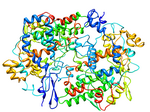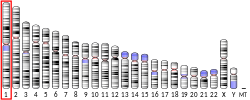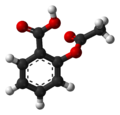Prostaglandins (PG) are a group of physiologically active lipid compounds called eicosanoids that have diverse hormone-like effects in animals. Prostaglandins...
26 KB (2,453 words) - 21:42, 14 November 2024
Prostaglandin E2 (PGE2), also known as dinoprostone, is a naturally occurring prostaglandin with oxytocic properties that is used as a medication. Dinoprostone...
35 KB (3,564 words) - 13:32, 19 November 2024
Prostaglandin F2α (PGF2α in prostanoid nomenclature), pharmaceutically termed dinoprost, is a naturally occurring prostaglandin used in medicine to induce...
12 KB (1,133 words) - 07:48, 16 September 2024
Prostaglandin E1 (PGE1) is a naturally occurring prostaglandin and is also used as a medication (alprostadil). In infants with congenital heart defects...
13 KB (1,105 words) - 07:16, 28 May 2024
Cyclooxygenase (redirect from Prostaglandin-endoperoxide synthase)
Cyclooxygenase (COX), officially known as prostaglandin-endoperoxide synthase (PTGS), is an enzyme (specifically, a family of isozymes, EC 1.14.99.1)...
16 KB (1,794 words) - 11:35, 14 November 2024
Cyclooxygenase-1 (redirect from Prostaglandin-endoperoxide synthase 1)
Cyclooxygenase 1 (COX-1), also known as prostaglandin-endoperoxide synthase 1 (HUGO PTGS1), is an enzyme that in humans is encoded by the PTGS1 gene....
18 KB (2,122 words) - 12:15, 2 June 2024
Prostaglandin H2 (PGH2), or prostaglandin H2 (PGH2), is a type of prostaglandin and a precursor for many other biologically significant molecules. It...
6 KB (505 words) - 07:56, 16 September 2024
Prostacyclin (redirect from Prostaglandin I2)
Prostacyclin (also called prostaglandin I2 or PGI2) is a prostaglandin member of the eicosanoid family of lipid molecules. It inhibits platelet activation...
20 KB (1,687 words) - 20:55, 12 September 2024
Prostaglandin analogues are a class of drugs that bind to a prostaglandin receptor. Wider use of prostaglandin analogues is limited by unwanted side effects...
3 KB (342 words) - 21:37, 11 July 2024
Prostaglandin inhibitors are drugs that inhibit the synthesis of prostaglandin in human body. There are various types of prostaglandins responsible for...
26 KB (2,117 words) - 14:49, 24 May 2024
Prostaglandin G2 (PGG2) is an organic peroxide belonging to the family of prostaglandins. The compound has been isolated as a solid, although it is usually...
3 KB (144 words) - 22:51, 20 September 2024
growths in the intestinal tract. Overexpression of COX-2 produces excess prostaglandins, which have been shown to increase the possibility of colorectal cancer...
42 KB (4,944 words) - 11:56, 4 April 2024
Cyclooxygenase-2 (redirect from Prostaglandin-endoperoxide synthase 2)
Cyclooxygenase-2 (COX-2), also known as prostaglandin-endoperoxide synthase 2 (HUGO PTGS2), is an enzyme that in humans is encoded by the PTGS2 gene....
30 KB (3,416 words) - 23:50, 20 September 2024
Prostaglandin E is a family of naturally occurring prostaglandins that are used as medications. Types include: Prostaglandin E1 also known as alprostadil...
5 KB (148 words) - 16:33, 31 October 2024
Prostaglandin E3 (PGE3) is a naturally formed prostaglandin and is formed via the cyclooxygenase (COX) metabolism of eicosapentaenoic acid. Prostaglandin...
2 KB (55 words) - 23:51, 3 April 2023
swelling from inflammation. It works by inhibiting the production of prostaglandins, endogenous signaling molecules known to cause these symptoms. It does...
23 KB (2,280 words) - 07:00, 5 November 2024
in animal fats. It is a precursor in the formation of leukotrienes, prostaglandins, and thromboxanes. Together with omega−3 fatty acids and other omega−6...
21 KB (1,899 words) - 17:30, 2 October 2024
enzymes are involved in the synthesis of key biological mediators, namely prostaglandins, which are involved in inflammation, and thromboxanes, which are involved...
111 KB (11,577 words) - 07:56, 16 November 2024
cyclooxygenase 1 and 2 (COX1 and COX2), thereby decreasing production of prostaglandins. Ketorolac was patented in 1976 and approved for medical use in 1989...
31 KB (2,646 words) - 16:31, 24 November 2024
Prostaglandin EP3 receptor (EP3, 53kDa), is a prostaglandin receptor for prostaglandin E2 (PGE2) encoded by the human gene PTGER3; it is one of four identified...
37 KB (4,318 words) - 07:29, 25 November 2024
The prostaglandin E2 (PGE2) receptors are G protein-coupled receptors that bind and are activated by prostaglandin E2. They are members of the prostaglandin...
5 KB (509 words) - 01:31, 17 December 2023
Misoprostol (category Prostaglandins)
Misoprostol is a synthetic prostaglandin medication used to prevent and treat stomach and duodenal ulcers, induce labor, cause an abortion, and treat...
51 KB (4,767 words) - 18:40, 3 October 2024
A prostaglandin antagonist is a hormone antagonist acting upon one or more prostaglandins, a subclass of eicosanoid compounds which function as signaling...
6 KB (768 words) - 10:51, 22 May 2024
Prostaglandin D2 (or PGD2) is a prostaglandin that binds to the receptor PTGDR (DP1), as well as CRTH2 (DP2). It is a major prostaglandin produced by...
11 KB (1,090 words) - 00:21, 17 February 2024
Prostaglandin receptors or prostanoid receptors represent a sub-class of cell surface membrane receptors that are regarded as the primary receptors for...
11 KB (879 words) - 12:45, 14 May 2023
Aspirin (section Prostaglandins and thromboxanes)
production of prostaglandins and thromboxanes is due to its irreversible inactivation of the cyclooxygenase (COX; officially known as prostaglandin-endoperoxide...
155 KB (16,756 words) - 20:21, 11 November 2024
known to convert dihomo-γ-linolenic acid and arachidonic acid into prostaglandins, and are the targets of nonsteroidal anti-inflammatory drugs (NSAIDs)...
20 KB (2,584 words) - 05:01, 11 May 2024
Prostaglandin E2 receptor 2, also known as EP2, is a prostaglandin receptor for prostaglandin E2 (PGE2) encoded by the human gene PTGER2: it is one of...
32 KB (3,685 words) - 02:56, 10 March 2024
Bimatoprost (category Prostaglandins)
during pregnancy or breastfeeding is generally not recommended. It is a prostaglandin analog and works by increasing the outflow of aqueous fluid from the...
15 KB (1,174 words) - 05:56, 11 November 2024
generates prostaglandin E (PGE) from prostaglandin H2. The synthase generating PGE2 is a membrane-associated protein. Humans express three prostaglandin-E synthase...
3 KB (205 words) - 15:33, 26 August 2023






















